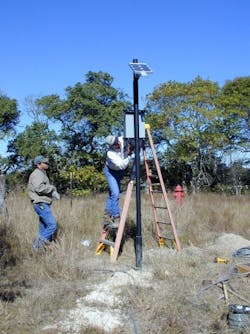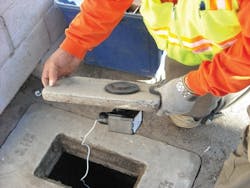| The logger and gateway are mounted inside a NEMA 4 plastic enclosure. Because all of the equipment is designed to withstand broad temperature ranges, no heating or cooling systems are needed. |
Each cellular gateway is equipped with a static IP address from the cellular carrier, allowing managers and engineers in the central office to query the data logger or cellular gateway at any time for status reports or to change configuration parameters.
LCRA has not needed special cellular antennas or amplifiers to ensure reliability connectivity. However, remote locations with a weak signal that is unreliable for cell phone calls can often still provide cellular data dependably by using a higher-gain antenna or, in some cases, an inexpensive cellular amplifier. Experienced systems integrators can help customers identify the proper accessories for a particular deployment scenario.
Overall, LCRA has found the solution to be effective and dependable, with no connectivity problems to date.
The data logger, intelligent cellular gateway, battery, and solar panel are mounted on a pole with an unobstructed view of the sun in the southern sky. The logger and gateway are then secured inside a plastic enclosure built to NEMA 4 standards for protection from moisture and dust. Mounted out of reach on the pole, the enclosure is protected from vandalism. Because all of the equipment is designed to withstand broad temperature ranges, no heating or cooling systems are needed. Even on a hot Texas day, the equipment performs consistently.
Conclusion
The combined solution is a dramatic operational improvement for LCRA. Remote locations that previously required a multi-hour round trip from the office can now be monitored safely from a desk. Real time information allows managers to more effectively monitor surges in demand or problems with the water distribution network.
The challenges faced by LCRA are familiar to water managers around the country: the water management industry is dependent on accurate monitoring information to ensure a safe, reliable water supply, yet remote locations are notoriously hard to monitor. While cellular data networks were once limited in scope and reliability, today's cellular networks have advanced significantly and now offer comparable reliability to some wireline networks. As a result, many water resource managers are now dependent on cellular data solutions to better manage water supply systems while reducing operating and maintenance costs. WW
About the Author: Peter Polson leads product management for AirLink fixed gateways and routers at Sierra Wireless. Prior to Sierra Wireless, Peter was president and co-founder of Junxion Inc. which pioneered the first managed cellular router solutions. Sierra Wireless acquired Junxion in 2008.More WaterWorld Current Issue Articles
More WaterWorld Archives Issue Articles




